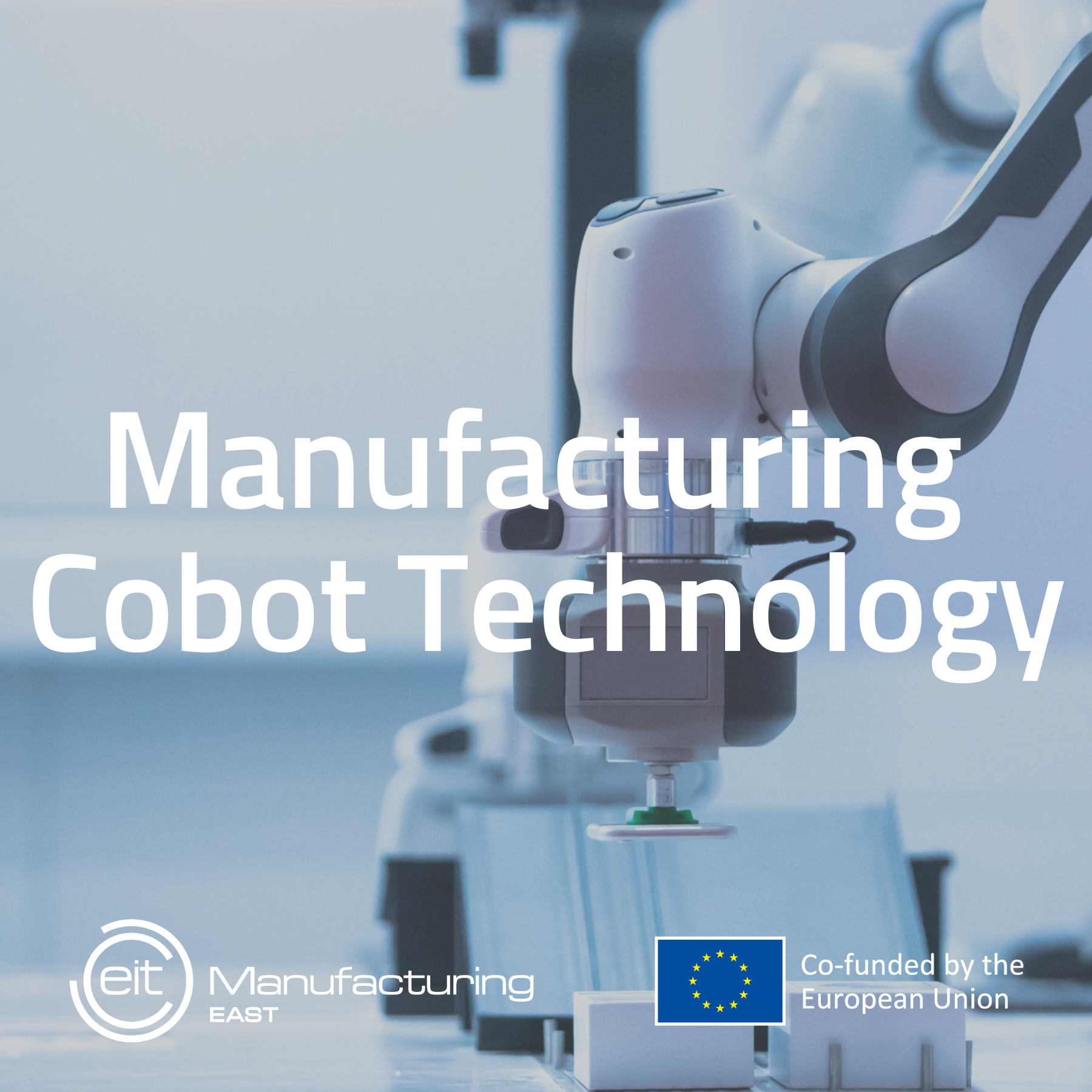In this article, FabLab experts Edin Škaljić and Ahmed Mujkanović from FabLab Bosnia and Herzegovina introduce us to the fascinating world of collaborative robots, commonly known as cobots. They provide a comprehensive explanation of what cobots are, detailing their unique characteristics and how they differ from traditional industrial robots. Additionally, Škaljić and Mujkanović highlight the numerous advantages cobots offer, such as increased safety, flexibility, and efficiency.
So let’s dive in…
What are cobots?
Cobots are the latest technology in robotics which have significantly changed the world of automation. Cobot stands for “collaborative robot”, meaning a robot that works in physical interaction with people in a shared workspace. These robots are collaborative because they can safely work around humans. They can do this because they are equipped with sensors that give them a “feel”. If a cobot gets interrupted while in operation, it will switch to a safe working mode. Traditional robots would simply continue their way, potentially harming the workers.
Besides the possibility of collaboration, these robots have several other advantages. They have enabled small and medium-sized businesses to be more competitive when compared to large corporations. For decades, large manufacturers have had the advantage of automation thanks to using traditional industrial robots. But these large, expensive, and complex robots are designed for high-volume and non-changing production processes, as opposed to the low-volume, mixed-production processes typical of smaller manufacturers.
Collaborative automation has become a versatile, cost-effective, and lightweight technology that enables companies of almost any size (and any level of technical expertise) to increase productivity, improve quality and respond more quickly to changing customer demands.
Advantages of cobots
Cobots have several unique characteristics that enable automation for a wide range of businesses:
- Compactness – Cobots are small, compact robots and can be used almost anywhere in the production process without occupying too much space.
- Installation and programming – Because they are easy to program, cobots can be easily installed by almost anyone. With convenient apps and software for smartphones and desktop computers, a cobot becomes operational in the blink of an eye.
- Flexibility – A cobot can effortlessly learn new operations and can thus work at different points in the production process.
- Mobility – Cobots are not heavy, and they move with ease. Placed on a mobile desk, they can smoothly perform new tasks at another location within the company.
- Consistency and precision – Cobots consistently perform actions in the programmed pattern with exactly the same force. This ensures equal quality and precisely positioned parts.
- Positive impact on employees – Workers are spared from monotonous or dangerous actions and can professionally develop through more creative tasks.
- Reduction of production costs – By using cobots, processes are simplified and production increases. Ultimately, this leads to a better result.
The impact of robots on employees
Production work, such as packing goods, stock replenishment or working on an assembly line is usually seen as monotonous and boring. Also, this type of work is often the cause of repetitive strain injuries (a condition caused by repeatedly performing a movement).
If a robot were to do the work of a production worker, the production worker could focus on other tasks. The tasks which require creativity and solution-oriented thinking, such as maintenance or quality control. Giving workers creative and solution-oriented tasks enriches their work and contributes to their personal development. It also encourages diversity and flexibility, creating an engaging work environment. Factors like these ensure that employees enjoy their work more, are more engaged in their assignments and are getting more productive.
Collaborative vs. Industrial robots
Industrial robots and cobots have many similarities, but cobots have some characteristics that make them suitable for wider industries’ deployment. Both types of robots have their advantages and disadvantages, which largely depend on the type of task and the products that need to be automated. Industrial robots are suitable for large companies that produce numerous pieces in a standardised way. Smaller companies can benefit from the flexibility and cost-effectiveness of cobots. However, one does not exclude the other. Large companies can also benefit from the advantages of cobots.
One fact stands out: IT TAKES ONLY 90 MINUTES TO TURN ANYONE INTO A COBOT DEVELOPER.
Programming a cobot
Traditional robots require a lot of knowledge and time to program specific actions. And they can only perform a few such actions. Contrary to traditional robots currently used in the industry, cobots are easy to program. With user-friendly software and mobile apps, cobots can quickly learn new actions. They can be manually moved to desired positions and this instruction is then stored in the software. Because cobots are so easy to program, they can be quickly implemented into a process and can even perform different tasks.
Various additional tools for cobots
Cobots are flexible because they can be equipped with different tools. Several manufacturers around the world are focusing on developing tools for collaborative robots that allow cobots to learn new tasks and become even more flexible. Tools can be divided into several categories: Grippers, End of Arm Tooling (EOAT), Vision and Software, Range Extenders, and Safety and Supply Systems.
Application of cobots
Thanks to a variety of tools, user-friendly software, and flexibility, cobots can perform a variety of tasks. The combination of different capabilities means that an infinite number of actions can be combined into one complete automation application. In theory, a cobot can learn anything. In practice, several applications are repeated most often:
- Welding – Welding is a task that must be done with utmost precision. Cobots are more precise than humans and hence will provide more consistent quality. Cobots can weld in various applications. Using cobots in welding has several advantages: it enables the use of available labour for minimal cost, less cleaning after welding, reduction of consumables costs and of total time-to-market.
- Grinding and polishing – Polishing, deburring, or sanding requires controlled action. Thanks to the built-in sensors, a cobot can follow any contour while applying a constant force to the surface. It allows the cobot to deliver consistent quality. Perfect for wood, stainless steel, or metal surfaces.
- Screwing and unscrewing – Simple, repetitive tasks like turning screws are perfect for cobots. With the right tools and software, the robot can easily be programmed to align an object with a hole, place parts precisely, and continuously apply the same force. Something impossible for humans, a cobot can easily do 40 hours a week.
- ‘Pick and place’ – ‘Pick and place’ refers to an uncomplicated task of picking up and moving objects, such as picking up parts from a large container and sorting them on an assembly line.
- Delivery of machines – Machine delivery is the placement of parts in, for example, a CNC lathe or a bending machine. While the cobot does its job, human operators are free. This improves worker safety, freeing them up for higher-level tasks. It also leads to increased productivity. Production can continue even after regular business hours, which guarantees higher production and business flexibility.
- Palletising (stacking boxes on pallets) – Palletising can be set up more efficiently with collaborative robots. Boxes are picked up by electric vacuum grippers and placed on pallets. New technologies eliminate the need for external air supply and hoses, which makes integration easier, lowers the costs and creates less noise and causation.
- Testing and quality control – Cobots can be valuable in testing and quality inspection in various industries. For example, a cobot can place objects in a testing device and sort them out. Thanks to the cameras, there are also possibilities for the cobot to perform a visual inspection.
- Glueing and sealing – Gluing and sealing are great tasks for a cobot. A syringe with glue is mounted at the end of the cobot. The cobot moves along the desired path and evenly distributes the adhesive or sealant.
- Soldering – Soldering is a meticulous task that can be perfectly automated with a collaborative robot. Cobots are extremely precise, more accurate than humans and thus provide exceptional quality.
Different brands of cobots
Over the years, the number of cobot manufacturers has increased significantly. In total, there are more than 30 companies that focus on the development and production of collaborative robots. The largest of them is Universal Robots A/S. They supply almost half of all cobots worldwide. Each cobot has its unique features and specifications. For an automation project, it is important to look at what the requirements for successful integration are. Specifications such as reach, payload, accuracy, speed, and the number of axes are important pillars in determining whether a cobot is suitable for the application.
In the FabLab laboratory in Sarajevo, Bosnia and Herzegovina, you can try the latest Universal Robots, the UR5e model.
The market
The price of cobots varies greatly depending on the quality, precision, load capacity and configuration of the connecting extensions.
- A cobot arm without connections, lower quality and below 5 degrees of freedom of movement (DOF), with a load capacity of up to 5kg costs up to 10,000 EUR.
- More versatile cobot arms, 5+ DOF, >5kg, range from 20,000 EUR to 40,000 EUR.
- Specialised hands start from 50,000 EUR.
It is estimated that by 2027, the market will grow more than five times compared to 2021. Market leaders are (2022, BIS Research Report):
- Universal Robots 46%
- Techman Robotics 9%
- Fanuc 9%
- Rethink Robotics 6%
- AUBO Robotics 5%
- Other 25%.
About the authors:
Edin Škaljić is a mechanical engineer and patent attorney, with over 20 years of experience in engineering and intellectual property. Edin is the founder of the FabLab network in Bosnia and Herzegovina.
Ahmed Mujkanović is a mechanical engineer and laboratory manager at FabLab Sarajevo.
About FabLab Bosnia and Herzegovina:
FabLab Bosnia and Herzegovina is an innovation-driven research and technology (RTO) organisation that develops innovative research platforms with the aim to improve research infrastructure, develop cutting-edge technologies, and accelerate innovation in Bosnia and Herzegovina (B&H).
Note: This text was originally published in the Bosnian language on the FabLab Bosnia and Herzegovina LinkedIn page. You can find it here.




